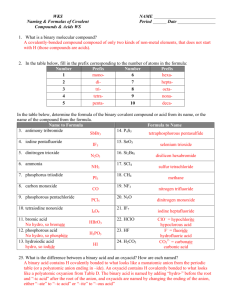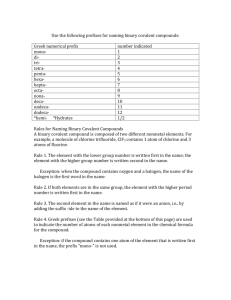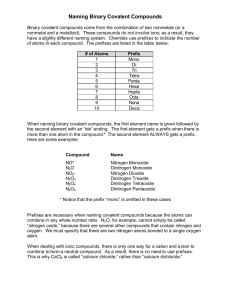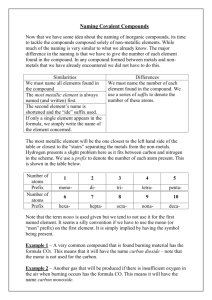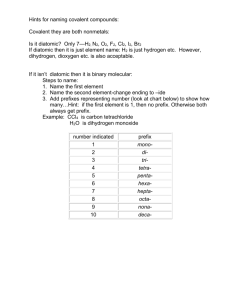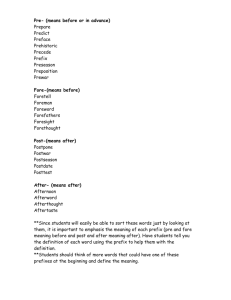Name HONORS CHEMISTRY ___/___/___ Naming
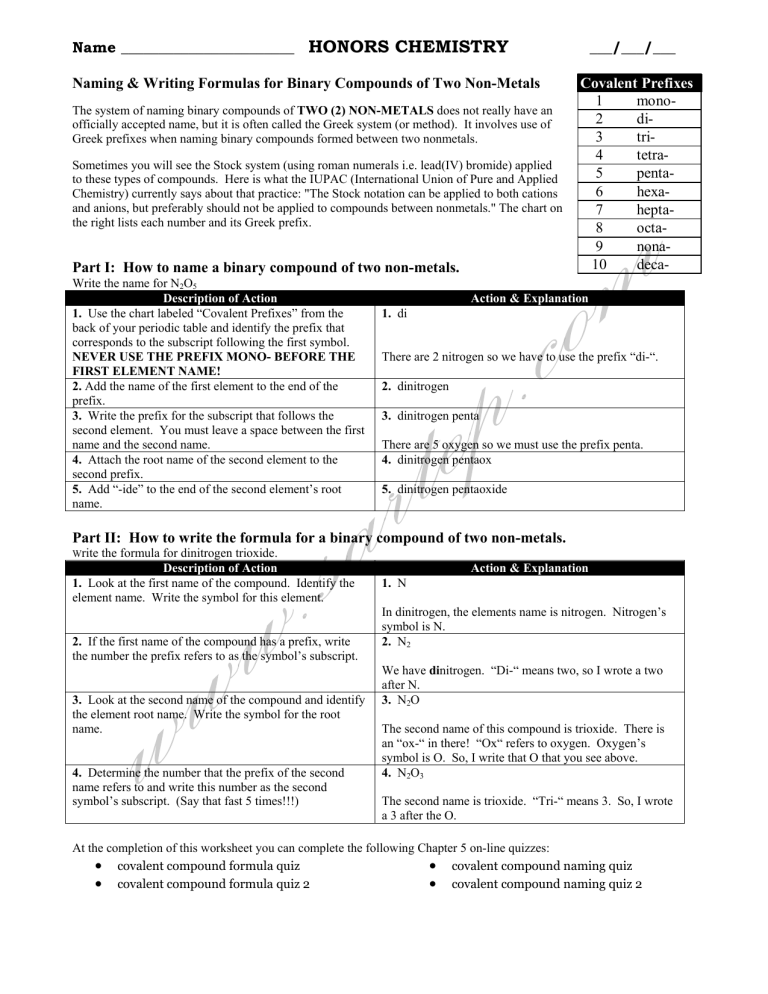
Name _______________________
HONORS CHEMISTRY
___/___/___
Naming & Writing Formulas for Binary Compounds of Two Non-Metals
The system of naming binary compounds of TWO (2) NON-METALS does not really have an officially accepted name, but it is often called the Greek system (or method). It involves use of
Greek prefixes when naming binary compounds formed between two nonmetals.
Sometimes you will see the Stock system (using roman numerals i.e. lead(IV) bromide) applied to these types of compounds. Here is what the IUPAC (International Union of Pure and Applied
Chemistry) currently says about that practice: "The Stock notation can be applied to both cations and anions, but preferably should not be applied to compounds between nonmetals." The chart on the right lists each number and its Greek prefix.
Covalent Prefixes
1
2
3
4
5
6
7
8
9 mono- ditri- tetra- penta- hexa- hepta- octa- nona-
Part I: How to name a binary compound of two non-metals.
Write the name for N
2
O
5
Description of Action
1.
Use the chart labeled “Covalent Prefixes” from the back of your periodic table and identify the prefix that corresponds to the subscript following the first symbol.
NEVER USE THE PREFIX MONO- BEFORE THE
FIRST ELEMENT NAME!
2.
Add the name of the first element to the end of the prefix.
3.
Write the prefix for the subscript that follows the second element. You must leave a space between the first name and the second name.
4.
Attach the root name of the second element to the second prefix.
5.
Add “-ide” to the end of the second element’s root name.
10 deca-
Action & Explanation
1.
di
There are 2 nitrogen so we have to use the prefix “di-“.
2.
dinitrogen
3.
dinitrogen penta
There are 5 oxygen so we must use the prefix penta.
4.
dinitrogen pentaox
5.
dinitrogen pentaoxide
Part II: How to write the formula for a binary compound of two non-metals.
W rite the formula for dinitrogen trioxide.
Description of Action
1.
Look at the first name of the compound. Identify the element name. Write the symbol for this element.
2.
If the first name of the compound has a prefix, write the number the prefix refers to as the symbol’s subscript.
3.
Look at the second name of the compound and identify the element root name. Write the symbol for the root name.
4.
Determine the number that the prefix of the second name refers to and write this number as the second symbol’s subscript. (Say that fast 5 times!!!)
Action & Explanation
1.
N
In dinitrogen, the elements name is nitrogen. Nitrogen’s symbol is N.
2.
N
2
We have di nitrogen. “Di-“ means two, so I wrote a two after N.
3.
N
2
O
The second name of this compound is trioxide. There is an “ox-“ in there! “Ox“ refers to oxygen. Oxygen’s symbol is O. So, I write that O that you see above.
4.
N
2
O
3
The second name is trioxide. “Tri-“ means 3. So, I wrote a 3 after the O.
At the completion of this worksheet you can complete the following Chapter 5 on-line quizzes:
covalent compound formula quiz
covalent compound formula quiz 2
covalent compound naming quiz covalent compound naming quiz 2
Homework:
Part I: Name the following.
1. KrF
2
4. H
2
O
7. XeF
4
10. PCl
5
2. BrF
5. NI
11. P
3
8. PCl
2
5
3
O
5
13. ICl
2
16. N
2
19. SiO
2
22. CO
2
14. SO
20. BF
23. SO
2
3
3
Part II: Write the formulas for each of the following.
1. chlorine monoxide 2. oxygen difluoride
4. dinitrogen trioxide
7. xenon trioxide
10. phosphorous trichloride
13. disulfur dichloride
16. silicon tetrachloride
19. silicon dioxide
5. nitrogen trifluoride
8. carbon dioxide
11. sulfur dioxide
14. boron trifluoride
20. boron trichloride
3. SCl
4
6. SF
6
9. CO
12. S
2
Cl
2
15. P
4
O
10
18. ClO
2
21. N
2
S
5
24. XeF
6
3. boron triphosphide
6. sulfur tetrachloride
9. diphosphorous pentoxide
12. bromine pentafluoride
15. nitrogen monoxide
21. dinitrogen pentasulfide
